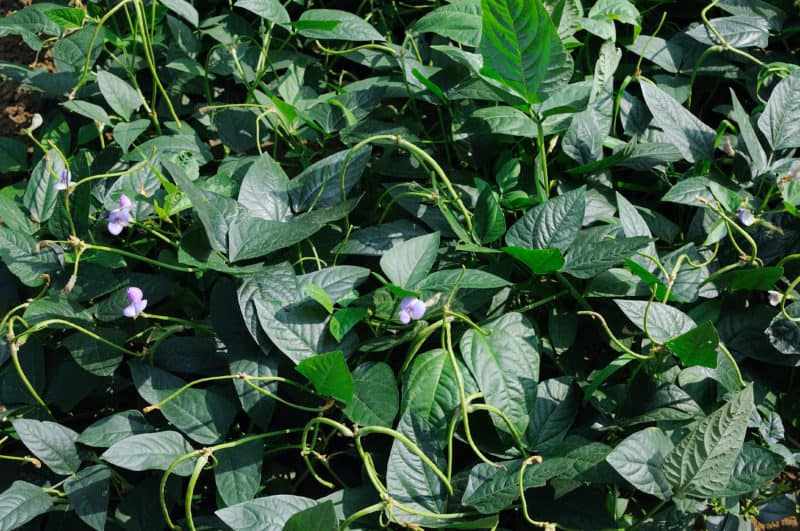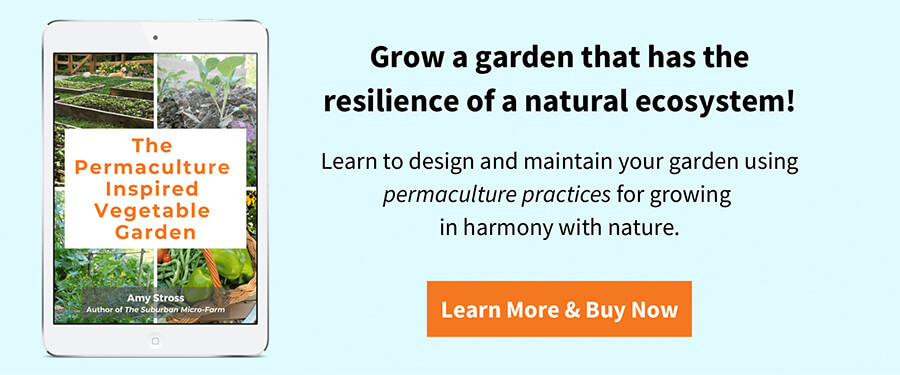Clay-Busting Plants That Fight Compaction
Got compaction? These clay-busting plants penetrate heavy soil to leave it loosened, aerated, and enriched. Jumpstart a regenerative garden ecology.


This page may contain affiliate links. Please read my disclosure for more info.
When Mr. TAF and I bought our dream homestead, visions of gardens danced in our heads. There was only one problem: an important fix to the exterior of the house brought various crews of workers.
In the process, big trucks and heavy machinery scraped the beautiful, rich topsoil from the yard, leaving behind compacted clay subsoil. 😭
Although I’m ready to jump into gardening mode now, I can’t ignore this setback. After all, soil is the foundation of a thriving permaculture garden! The best pre-step to planting a garden is to regenerate a rich soil ecology. Clay-busting plants are essential to my plan.
The following clay-busting plants can heal soil in existing vegetable gardens and perennial food forests!
Healing Soil with Clay-Busting Plants
On my new garden site, my goal is to punch through the compacted soil to loosen and aerate it. Next, I want to inject it with rich, organic matter that my crops will love.
To really jumpstart my new garden’s success, I also aim to build soil life and fungal networks to develop a rich, regenerative garden ecology.
The best news? Clay-busting plants can do all of this for me, no back-breaking work needed!
Interestingly, although tilling is a soil-loosening strategy, it may cause more harm than good by destroying soil structure, soil life, and fungal networks. Read more about the benefits of a no till garden.
The following list of clay-busting plants have gotten me out of a jam or two in the past!
Would you like to grow more food with less effort? Check out my mini guide, The Permaculture Inspired Vegetable Garden.
5 Annual Edible Clay-Busting Plants
Use the following annual plants as a cover crop in vegetable beds that need a rest or a boost. Or interplant them among crops to create compost in place.
These clay-busters can also act as soil-healing placeholders in areas slated for future annual or perennial gardens.
In fact, all of the following plants are commonly sown in the understory of food forests and fruit tree guilds. Let them self-sow to become semi-permanent sources of chop-and-drop mulch. It’s an easy way to generate compost in place and build soil without the labor!
While some of these plants have taproots (also called spike roots), others have dense, fibrous roots. What they all have in common is a vigorous growth habit that persists even when the going is tough.


#1: Artichoke (Cynara scolymus)
Artichokes develop deep, sturdy taproots and are a great mulch plant—both benefits to healing soil.
The taproots bust through heavy soil, and a bonus to planting them is that they’re edible!
Short-season annual varieties like Imperial Star or Green Globe are quick-growing and can yield a harvest of edible flower buds from midsummer to mid-fall.
Harvest at bud stage, then chop and drop the entire plant in place to make quick mulch and build soil in place. Leave the roots to decompose.
Note: Artichoke is related to thistle, and the plants are spiny. I wear rose pruning gloves to handle the plants.
Learn more about growing artichokes here.
#2: Daikon Radish (Raphanus sativus)
Daikon radishes might be my favorite clay-busting vegetable, plunging up to 24 inches into the soil. Also, they’re delicious!
Sow them spring, summer, or fall. Harvest some for eating around 50 days, then let the rest grow until they flower or die back. Snap or cut them off at ground level and let them rot.
These magicians break up clay and build humus as they rot. The flowers attract beneficial insects, too! Here are the seeds that I buy.


Daikon radishes growing in the garden.
Would you like to learn more about improving the quality of your soil, reducing maintenance, and increasing yield?
You’ll find loads of information just like this in my award-winning book, The Suburban Micro-Farm.
#3: Cowpea (Vigna unguiculata)
Like many legume species, cowpeas (southern peas) have vigorous, dense, fibrous roots that break up clay soil. As nitrogen fixers, they enrich and enliven the soil.
Sow in the spring as a summer cover crop. They grow quickly to suppress weeds, and the flowers attract beneficial insects.
To achieve maximum root growth and provide maximum nitrogen content to the soil, cut the plants back while flowering (before they set pods).
Can you harvest cow peas to eat? Yes, you can harvest them as you would green beans or wait until the pods dry to harvest soup beans. A benefit of planting them as a combination cover crop-vegetable crop is that the flowers become an insectary for beneficial insects.
Cowpeas are easily killed by frost when grown as a crop. Simply cut them back in the fall to allow the plant matter to decompose over the winter. Bush varieties are easier to manage.
Try this beautiful purple variety!


#4: Mustard (Brassica spp.)
This precursor to our beloved Brassica crops (broccoli, cabbage, kale, etc.) can often be found growing as a weed in areas that have become compacted. That’s because it is a superstar clay-busting plant with a massive, fibrous root system.
It’s a good reminder that nature allows the right plants to grow where they’re needed. Read more about the benefits of weeds.
Mustard is a vigorous producer of biomass, so you can grow it as a chop-and-drop green manure/mulch. In addition, it is known to suppress soil-borne pathogens.
*In the vegetable garden, cut mustard back while flowering (before it goes to seed), at least three weeks before planting a spring crop.
Timing is important for two reasons.
First, mustard disperses vigorously if allowed to go to seed, unless you want to harvest the seeds to make mustard (the condiment).
Although my home site hasn’t been pasture for over 80 years, mustard still pops up along the driveway. It was likely grown as a forage crop that escaped. I don’t mind—the pollinators love it—but you may not be as appreciative.
Second, mustard can have allelopathic effects on the soil while it employs its disease-suppressing action, which is the main reason for a 3-week delay between cutting the plants back and planting a crop.
Incorporate plant matter into the soil with a digging fork immediately after cutting it to take advantage of its disease-suppressing benefits, and do not follow mustard with Brassica crops.
The leaves, flowers, and seed are edible, which is why many gardeners allow it to self sow in a food forest or fruit tree guild. Chickens love it, too!
Here is the cover crop variety of mustard seed that I like.


#5: Annual Sunflower (Helianthus anuus)
How about a clay-busting plant that brings cheer to the garden? Sunflowers are an excellent choice for a summer cover crop.
Look for varieties that don’t need staked—they’ll establish vigorous roots deep into compacted soil. The award-winning and super-productive variety soraya has sturdy stems and minimal pollen, making it a good pick for a cut flower. Or you can go with the Mongolian Giant variety from Botanical Interests, known for its large, edible seeds.
Did you know that the buds and petals are edible, too? I wouldn’t want to miss out on enjoying the pretty flowers, but it’s certainly an option.
Sunflowers are a superb insectary, attracting hundreds of varieties of insects, as well as birds and squirrels. They can also provide forage for chickens.
In late winter, cut the plants back to the ground, but leave the roots to decompose and enrich the soil. Although sunflower roots are known to have an allelopathic effect on the soil, allowing them to decompose over the winter prevents this from being a problem for spring planting.
Are you returning an area with clay soil to nature? Read about planting native perennial sunflowers.


Perennial Clay-Busting Plants for the Food Forest
I don’t recommend planting perennial clay-busters in the annual vegetable garden, but they’re an excellent choice when preparing a site to be a future food forest or fruit tree guild. These clay-busters can also be sown as a soil-enriching understory in an existing food forest or orchard.
My favorite clay-busting perennials are:
You’ll notice that a few of my favorites tend to make it onto some gardeners’ list of hated weeds! Remember, these pioneering plants have the most vigorous roots to bust through clay and enrich the soil as they decompose. In addition, the above-ground plant matter can enrich the topsoil as chop-and-drop mulch.
If nature is left to itself, fertility increases.” ~ Masanobu Fukuoka, The One Straw Revolution: An Introduction to Natural Farming
Tools for Clay-Busting
The Broadfork
If you’re getting started with a bare spot of clay subsoil (like me), then a broadfork is the tool for you. Use it for hand tilling, which is more gentle than regular tilling. Beware that your first pass through the soil with this tool will be quite the workout!
Wait until the soil has dried out before getting started. If you can walk across the area without your boots getting stuck, then you’re ready to start! Work backwards over the garden area with the broadfork so as not to step on loosened soil.
Next, sow seeds of your clay-busting cover crop, water regularly, and watch the magic happen!
The Digging Fork
While I mainly use the broadfork to jumpstart soil regeneration, the digging fork is my favorite tool for long term maintenance. I use it to poke holes throughout the garden to aerate the soil every spring and fall. It’s easier to wield than the broadfork!
Soil Amendments for Clay
Among my favorites are biochar, greensand, and worm castings for enriching the soil once the clay-busting plants have loosened and aerated it. See them all (and more) in my Improving Clay Soil Amazon Shop.
Are clay-busting plants magic?
Well, yes and no. Never underestimate nature’s ability to heal soil, fertilize, and compost in place so that you don’t have to lug around so many wheelbarrows of compost and mulch. In that sense, clay-busting plants are amazing!
However, clay soil takes time to improve. It’s a process, rather than a one-time, quick fix. For example, daikon radishes are excellent at drilling through compaction. They may not drill super deep on their first planting, but they will go ever deeper with each successive planting.
Clay-busting plants are ready to go to work for you.
What clay-busting plants have you put to use in your garden?
READ NEXT:









